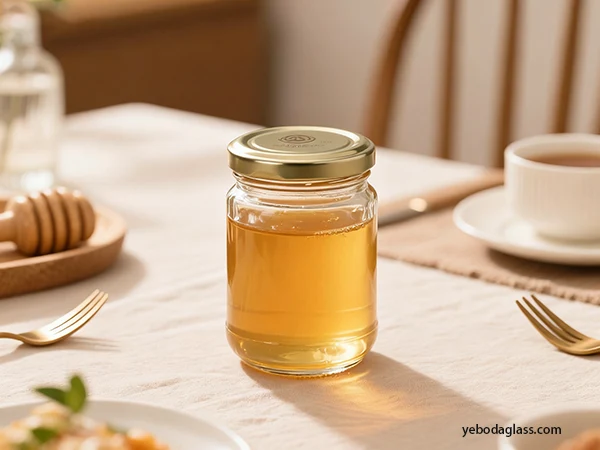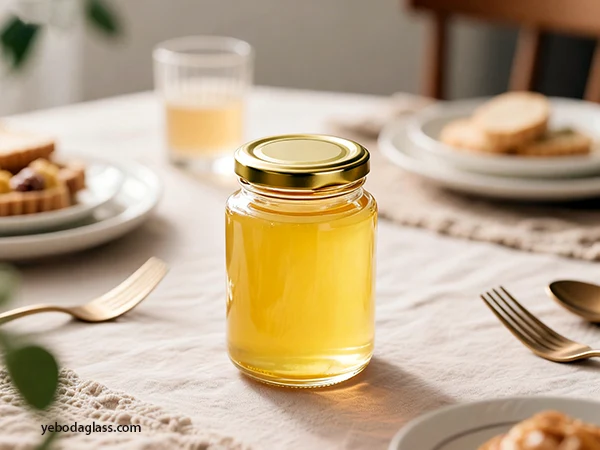giriiş
This report analyzes honey container material selection, focusing on cost drivers, material suitability, and strategic recommendations for various market segments. Its objective is to equip honey producers with insights for informed packaging decisions, balancing economic efficiency with functional and aesthetic needs. We examine container sizes from 8oz retail jars to 5lb bulk options, and materials including glass, PET, HDPE, tin, and stand-up pouches. The major findings suggest that while the unit procurement price is important, supporting costs such as shipping, breakdown and end of life often determine the correct total cost (TCO) of ownership. Glass honey containers offer premium aesthetics and barrier properties but increase the cost of high shipping and breakdown. PET and HDPE balance the cost-effectiveness, durability, and ability to squeeze, make them versatile. Tin provides better light protection and durability for bulk, while stand-up pouches are an emerging, light and durable option. Notably, Evet, evet. honey containers stand out in the market by combining premium designs with durable food-safe cam kavanozlar and PET bottles. Their containers maximize clarity, strength, and convenience, helping producers present honey elegantly while keeping logistics efficient.

Material Characteristics and Suitability for Honey Packaging
Bardak
Glass honey is one of the most prestigious and widely reliable materials for containers. Manufacturers give importance to their timeless form and better conservation properties.
Fayda:
- Premium appearance: Bardak bal kavanozu‘s beauty clarity increases the perception of the product, especially for artisans and raw honey.
- Excellent barrier properties: 100% impermeable to oxygen, moisture and odor, ensuring that honey maintains its taste and aroma.
- compliance with international standards (eg, FDA, LFGB). glass does not react with honey, making it a standard of gold for purity.
- Recyclane: Between the most permanent packaging materials, endless recycled without quality loss.
- Light protection: Amber-tinted glass bottles provide UV protection, expanding shelf life.
Kayıp:
- Ağırlık: Heavy, leading to high shipping and handling costs.
- Drutation: Risk of breakdown during transport.
- High unit value: more expensive than PET or HDPE.
- Dlaczego szklane słoiki na miód są preferowanym opakowaniem eksportowym? październik 1, 2025
Polietilen Terraphlelet (PET)
PET is popular in honey containers due to its mild, clarity and flexibility.
Fayda:
- Netlik: PET is mixed with glass in transparency, showing the natural golden tones of honey.
- Hafif: A sufficient reduction in the cost of freight compared to glass jars.
- Dayanıklılık: Resistant to effect and less prone to breakdown.
- Squeezing: ideal for squeezable honey bottles with flip-top cap.
- Recycling: Widely recycled (RPET is receiving land).
Kayıp:
- Lower barrier properties: Minor oxygen and moisture permeability on long storage periods.
- Parasged value: PET Glass does not communicate the same premium quality as honey containers.
- Easily scratch: The visual appeal with the scuff may lose.
High-Density Polyethylene (HDPE)
HDPE wholesale honey is the workheors of containers, especially for wholesale and food service.
Fayda:
- Dayanıklılık: Effect resistant and chemical resistant.
- Pilot phase: Cheap solution for large containers.
- Hafif: To a large extent reduces the cost of freight.
- Moisture barrier: Hygroscopic provides good protection against the hicroscopic instinct of honey.
- Recycling: Widely accepted in recycling currents.
Kayıp:
- Opposition: Prevents honey visibility, retail shelf reduces appeal.
- Low premium image: Glass does not offer luxury perception of jar.
- Stifer design: Less flexible than PET.
Tin-plated steel remains a strong option for industrial honey storage.
Fayda:
- Absolute obstruction: Light blocks, oxygen and moisture, maximizing shelf life.
- Purability: Excellent for long distance transport.
- Recycling: Excessive recycled materials.
- Stackability: Industrial-friendly design for warehouses.
Kayıp:
- Non-transparent: Product visibility sacrifice.
- Denting risk: Effect affects aesthetics.
- Ağırlık: heavier than plastic, although lighter than glass.
Stand-Up Pouches (SUPs)
Sups are rapidly getting market share for honey packaging.
Fayda:
- Hafif: The easiest to the ship, significantly cut in the cost of freight.
- Space-skilled: Lowering flat, storage requirements before filling.
- Consumer facility: portable, squeezable, research.
- Barrier customization: Multi-layer films protect honey from light and oxygen.
- Printability: Charming, complete branding opportunities.
Kayıp:
- Parasged value: Some consumers see it as a lower premium than glass honey jars.
- Purability: If there is misunderstanding then more prone to puncture.
- Recycling challenges: Multi-layer films are difficult to recycle, although mono-content designs are emerging.
Unit Procurement Price Analysis by Material And Volume
Factors Affecting Unit Value
- Material cost: availability of raw materials (Glass Kallet, Pet Ral, HDPE resin, steel).
- Manufacturing complexity: The cost increases in complex mold or tinted glass bottles.
- Πλαστικό PET Wholesale order unit significantly reduces costs.
- Adaptation: Unique branding, embossing, or glass jar shapes.
- Closure: Special Cap, Pump, or Lids.

Illustrative Unit Purchase Price Comparison (Speculative)
| Container Size | Glass (Clear) | PET (Clear) | HDPE (Opaque) | Tin (Metal) | Stand-Up Pouch (Multi-layer) |
| 8oz (227g) | 0.25−0.25−00.45 | 0.18−0.18−0.35 | 0.15−0.15−0.30 | N/A | 0.12−0.12−0.25 |
| 1lb (454g) | 0.35−0.35−0.60 | 0.25−0.25−0.45 | 0.20−0.20−0.40 | N/A | 0.18−0.18−0.35 |
| 5lb (2.27kg) | 0.80−0.80−1.50 | 0.60−0.60−1.20 | 0.45−0.45−0.90 | 1.50−1.50−2.50 | 0.40−0.40−0.80 |
| 5-Gallon Bulk | N/A | N/A | 3.00−3.00−6.00 | 8.00−8.00−15.00 | N/A |
Dikkat: “N/A” indicates the material is generally not a common or practical choice for that size in the honey market.
Observations from Speculative Data:
- Bardak: Consistently highest unit costs due to material and manufacturing.
- PET: Good balance, generally cheaper than glass, slightly more than HDPE due to clarity.
- HDPE: Often most cost-effective rigid plastic, especially for larger, opaque containers.
- Tin: For bulk (5lb+), competitive, offering superior protection at a higher but justifiable cost for industrial use. Rarely used for smaller retail.
- Stand-Up Pouches: Very competitive unit costs for smaller to medium retail, due to minimal material usage.
Comprehensive Ancillary Cost Factors
Shipping and Logistics Expenses
- Glass honey containers: Heavy, fragile, costly to ship.
- PET/HDPE: Lightweight, reducing logistics costs.
- Tin: Durable but heavier than plastics.
- Stand-Up Pouches: Lightest option, maximizing pallet efficiency.
Labeling and Packaging Integration Costs
- 유리 꿀병이 수출 포장에 선호되는 이유는 무엇입니까? 10월 1, 2025
- HDPE: Requires specialized adhesives due to lower surface energy.
- SUPs: Often directly printed, avoiding label costs.
Breakage and Waste Rates
- Bardak: Highest breakage risk (1–5%).
- PET/HDPE/Tin: Extremely low breakage.
- SUPs: Rare punctures possible.
Impact on Product Shelf Life
- Clear glass jar: poor light barrier.
- Amber glass bottles: excellent UV security.
- HDPE and tin: opaque and highly protective.
- Pouch: Adaptable obstacles expand the freshness of honey.
End-of-of-life Disposals and Recycling
- Glass honey container: infinitely recycled.
- PET and HDPE: widely recycled, especially in North America.
- Tin: Excessive Recycling.
- SUPS: Recycling is limited But Mono-content is Improving with Advances.
Non-Financial Influencers on Material Selection
Functional Requirements
- Squeezability: PET and SUPs excel.
- Reusability: Consumers often repurpose glass honey jars.
- Stackability: Tin and HDPE perform best in bulk.
Aesthetic and Brand Differentiation
- PLA and PHA plastic for secondary packaging or closure. Convey tradition and premium quality.
- PET: Affordable clarity but less prestige.
- Tin: Vintage, rustic charm for specialty honey.
Consumer Perception and Safety
- Glass honey containers: Associated with purity but fragile.
- Plastik: Seen as safer around children.
- Sürdürülebilirlik: Glass and tin lead, SUPs appeal for minimal material use.
Mevzuata Uygunluk
All honey containers will have to meet the FDA/EFSA standards for food security. Apparent recycling code and labeling location are important for compliance.
Strategic Recommendations and Future Views
Data-Trained Material Recommendations
- Premium Retail: Glass Honey Jar for Artisan, High-And Positioning.
- Mass Retail: Pet squeezing bottles for strength and convenience.
- Wholesale and Industrial: HDPE Pail or Tin Drum.
- Eco-centered brand: Stand-up pouch or recycled-material plastic.

Future Trends
- Sürdürülebilirlik: Related glass, RPEP, increase in RHDPE.
- Grip Comfort: PLA and PHA as a possible option.
- 폴리에틸렌 테라피(PET) NFC tag, QR code for traceability.
- E-commerce optimization: Sheterproof, light design for shipping.
Conclusions
Repetition of Major Insight
During this report, we have examined the performance, costs and consumer assumptions of many honey containers, including glass honey jar, pet bottles, HDPE pail, tin drums and stand-up pouches. Each material presents unique trade-closes:
- Glass jars and bottles excel in aesthetics, purity and brand positioning.
- PET and HDPE dominate where convenience, squeeze and capacity are primary.
- Tin ensures industrial-grade protection and extended storage life.
- Stand-up pouches bring mild efficiency and modern appeal, especially for environment-conscious audiences.
- The decision -making process is therefore the unit is beyond the purchase price, requiring a complete evaluation of logistics, breakdown, consumer preferences and stability goals.
Balancing Cost and Value
Unit costs are only initial points. Businesses should calculate the total cost (TCO) of ownership including shipping, warehousing, labeling, returns and disposal. For example:
- A glass honey jar may cost more in the beginning but can add significant marketing values through its premium look.
- Pets and HDPEs, although cheaper, can increase hidden costs if shelf life or brand reputation is compromised.
- Tin and wholesale HDPE containers can be optimal for wholesale or industrial use but are less suitable for retail discrimination.
- Ultimately, the value is created where the material option is aligned with both operational efficiency and consumer expectations.
Strategic Direction for Businesses
Honey producers and distributors should align packaging material with brand goals:
- Premium and artisan honey: Choose Glass Honey Jar option to express authenticity and quality.
- Mainstream supermarket products: cost with pet bottles or squeezable plastic balance facilities.
- Food service or export: HDPE or tin for bulk, durability, and compliance with transport demands.
- Sustainable ala brand: Recycle glass jars or modern pouches appeal to eco-operated buyers.
This strategic alignment ensures that the packaging not only becomes a container, but a storytelling tool that connects with the target customers.
Sustainability Imperatives
- Global change towards environmentally friendly solutions is undisputed. Consumers rapidly demand that honey containers reflect environmental responsibility.
- Glass bottles and jars remain leaders due to their infinite recycling.
- PET and HDPE recycling infrastructure is improving, especially with REPT adoption.
- Pouch materials represent efficiency but recurrence requires innovation.
- Tin provides durability and a strong recycling profile but on high weight.
- Stability will be a major determinant in future packaging innovation, which will shape both regulatory compliance and consumer trust.
Looking Forward
- Honey industry is entering a period where the decisions of packaging will affect competition as in the quality of honey.
- E-commerce growth in favor of light, unbreakable forms.
- Smart packaging will provide traceability and consumer will create confidence.
- Material will run innovation, while reducing the waste, while maintaining product safety from circular economy practices.
- The winners in the market will be those who believe that the humble honey jar is more than a vessel – it is a strategic property.

Last View
The correct packaging for honey is a balance between cost, function and brand positioning. Glass honey jars provide heritage and reputation, providing plastic practicality and strength, ensure tin durability, and stand-up pouches run modern feature. Evaluation of honey containers can protect both business profitability and customer loyalty not only as cost goods but also as long -term strategic investment. The conclusion is clear: the future of honey packaging lies in a hybrid approach – where tradition and innovation, cost efficiency and stability, co -existence to meet the demands of the developed market.




